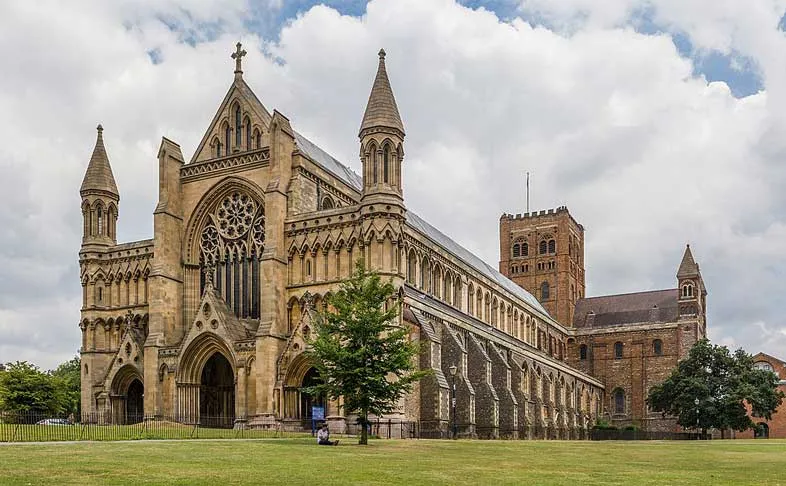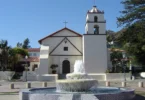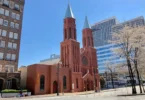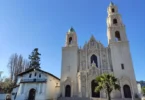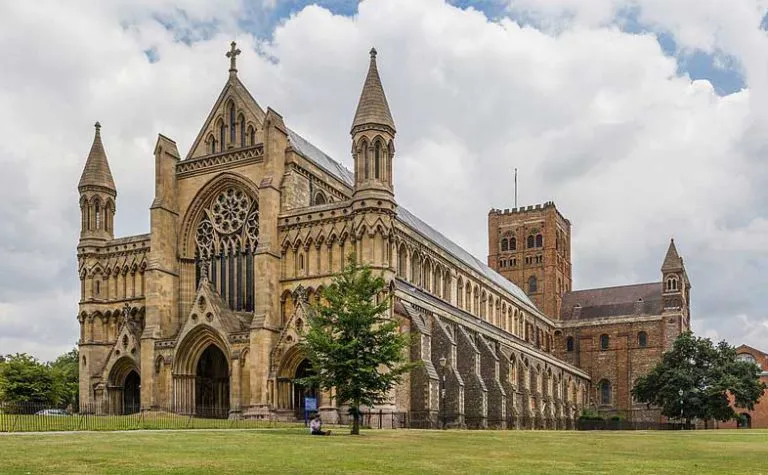
Introduction
St Albans Cathedral, officially the Cathedral and Abbey Church of St Alban but often referred to locally as “the Abbey”, is a Church of England cathedral in St Albans, England. Much of its architecture dates from Norman times. It ceased to be an abbey following its dissolution in the 16th century and became a cathedral in 1877.
Although legally a cathedral church, it differs in certain particulars from most other cathedrals in England, being also used as a parish church, of which the dean is rector with the same powers, responsibilities and duties as that of any other parish. At 85 metres long, it has the longest nave of any cathedral in England.
Probably founded in the 8th century, the present building is Norman or Romanesque architecture of the 11th century, with Gothic and 19th-century additions.
History of the Abbey and Cathedral
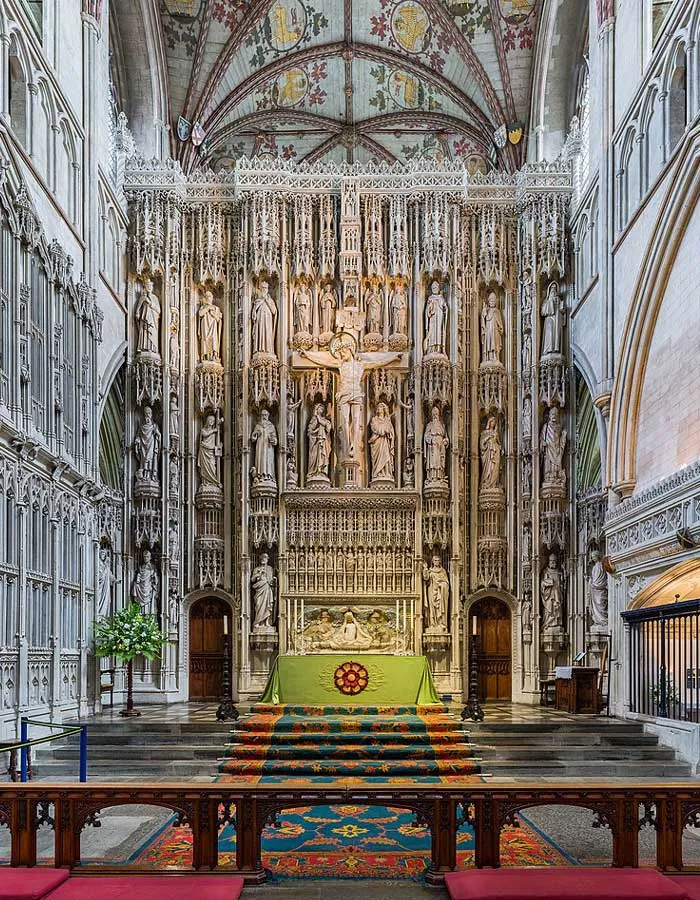
A memoria over the execution point holding the remains of Alban existed at the site from the mid-4th century (possibly earlier); Bede mentions a church and Gildas a shrine. Bishop Germanus of Auxerre visited in 429. The style of this structure is unknown; the 13th-century chronicler Matthew Paris (see below) said the Saxons destroyed the building in 586.
Saxon buildings – Offa II of Mercia, is said to have founded a double monastery at St Albans in 793. It followed the Benedictine rule. The Abbey was built on Holmhurst Hill, now Holywell Hill, across the River Ver from the ruins of Verulamium. Again there is no information to the form of the first abbey. The Abbey was probably sacked by the Danes around 890 and, despite Paris’s claims, the office of abbot remained empty from around 920 until the 970s when the efforts of Dunstan reached the town.
There was an intention to rebuild the Abbey in 1005 when Abbot Ealdred was licensed to remove building material from Verulamium. With the town resting on clay and chalk, the only tough stone is flint. This was used with a lime mortar and then either plastered over or left bare. With the great quantities of brick, tile and other stone in Verulamium, the Roman site became a prime source of building material for the Abbey and other projects in the area.
Sections demanding worked stone used Lincolnshire limestone (Barnack stone) from Verulamium; later worked stones include Totternhoe freestone from Bedfordshire, Purbeck marble, and different limestones (Ancaster, Chilmark, Clipsham, etc.).
Renewed Viking raids from 1016 stalled the Saxon efforts and very little from the Saxon abbey was incorporated in the later forms.
Norman Abbey
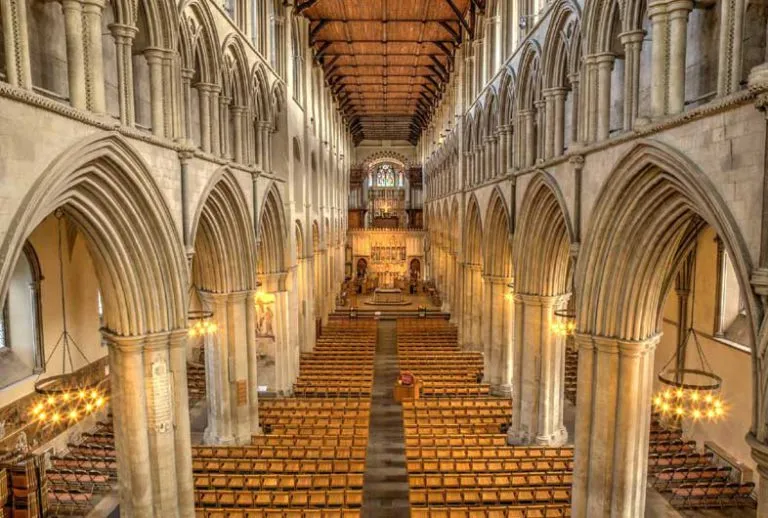
Much of the current layout and proportions of the structure date from the first Norman abbot, Paul of Caen (1077–1093). The 14th abbot, he was appointed by his uncle, the new Archbishop of Canterbury, Lanfranc.
Building work started in the year of Abbot Paul’s arrival. The design and construction was overseen by the Norman Robert the Mason. The plan has very limited Anglo-Saxon elements and is clearly influenced by the French work at Cluny, Bernay and Caen, and shares a similar floor plan to Saint-Étienne in Caen and Lanfranc’s Canterbury although the poorer quality building material was a new challenge for Robert and he clearly borrowed some Roman techniques, which were learned while gathering material in the ruins of Verulamium.
To take maximum use of the hilltop the Abbey was oriented to the south-east. The cruciform abbey was the largest built in England at that time, it had a chancel of four bays, a transept containing seven apses, and a nave of ten bays to fifteen bays long overall. Robert gave particular attention to solid foundations, running a continuous wall of layered bricks, flints and mortar below and pushing the foundations down to twelve feet to hit bedrock. Below the crossing tower special large stones were used.
The tower was a particular triumph, it is the only 11th-century great crossing tower still standing in England. Robert began with special thick supporting walls and four massive brick piers. The four-level tower tapers at each stage with clasping buttresses on the three lower levels and circular buttresses on the fourth stage. The entire structure masses 5,000 tons and is 144 feet high. The tower was probably topped with a Norman pyramidal roof; the current roof is flat. The original ringing chamber had five bells, two paid for by the Abbot, two by a wealthy townsman, and one donated by the rector of Hoddesdon. None of these bells has survived.
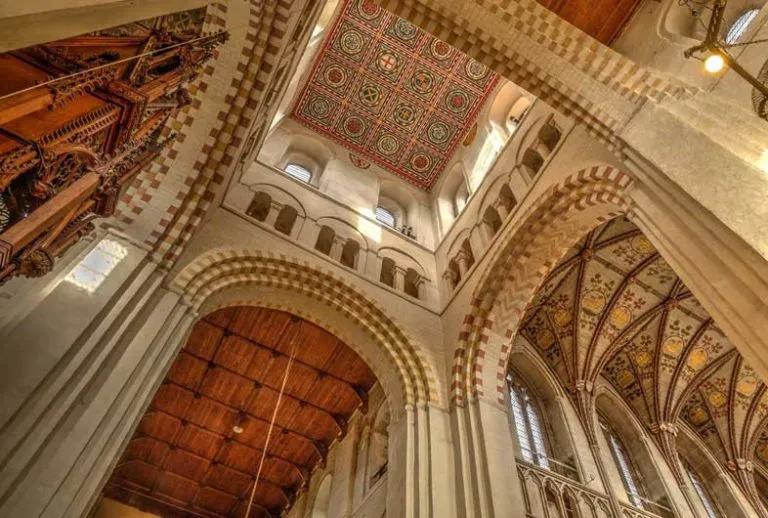
There was a widespread belief that the Abbey had two additional, smaller towers at the west end. No remains have been found. The monastic abbey was completed in 1089 but not consecrated until Holy Innocents’ Day (28 December), 1115, by the Archbishop of Rouen. King Henry I attended as did many bishops and nobles. A nunnery (Sopwell Priory) was founded nearby in 1140.
Internally the Abbey church was bare of sculpture, almost stark. The plaster walls were coloured and patterned in parts, with extensive tapestries adding colour. Sculptural decoration was added, mainly ornaments, as it became more fashionable in the 12th century, especially after the Gothic style arrived in England around 1170. In the current structure the original Norman arches survive principally under the central tower and on the north side of the nave. The arches in the rest of the building are Gothic, following medieval rebuilding and extensions, and Victorian era restoration.
The Abbey was extended in the 1190s by Abbot John de Cella (also known as John of Wallingford) (1195–1214); as the number of monks grew from fifty to over a hundred, the Abbey church was extended westwards with three bays added to the nave. The severe Norman west front was also rebuilt by Hugh de Goldclif, although how is uncertain; it was very costly but its ‘rapid’ weathering and later alterations have erased all but fragments. A more prominent shrine and altar to Saint Amphibalus were also added.
The work was very slow under de Cella and was not completed until the time of Abbot William de Trumpington (1214–1235). The low Norman tower roof was demolished and a new, much higher, broached spire was raised, sheathed in lead.
The St Albans Psalter (1130–1145) is the best known of a number of important Romanesque illuminated manuscripts produced in the Abbey scriptorium. Later, Matthew Paris, a monk at St Albans from 1217 until his death in 1259, was important both as a chronicler and an artist. Eighteen of his manuscripts survive and are a rich source of contemporary information for historians.
Nicholas Breakspear was born near St Albans and applied to be admitted to the Abbey as a novice, but he was turned down. He eventually managed to be accepted into an abbey in France. In 1154 he was elected Pope Adrian IV, the only English Pope there has ever been. The head of the Abbey was confirmed as the premier abbot in England also in 1154.
The Story of Saint Alban
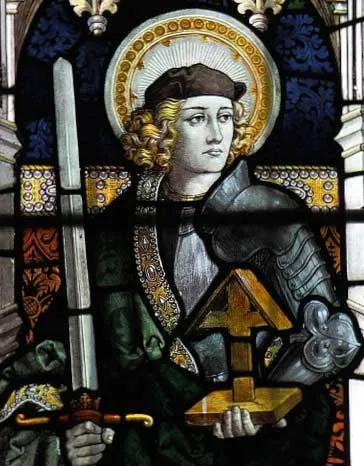
Saint Alban is venerated as the first-recorded British Christian martyr, for which reason he is considered to be the British protomartyr. Along with fellow Saints Julius and Aaron, Alban is one of three named martyrs recorded at an early date from Roman Britain (“Amphibalus” was the name given much later to the priest he was said to have been protecting). He is traditionally believed to have been beheaded in Verulamium (modern St Albans) sometime during the 3rd or 4th century, and his cult has been celebrated there since ancient times.
The Story of Saint Alban is a remarkable one. It not only takes us back to the beginning of the Christian faith in Britain and to a time when religious freedom was forbidden, but it is also an astonishing account of standing up for what you believe in.
Alban lived in the early third century in the Roman city of Verulamium, just down the hill from where the Cathedral stands today. One day he gave shelter to a stranger fleeing from persecution. This stranger was a Christian priest, now known as Amphibalus. While sheltering the priest, Alban was inspired by how important faith was to the priest and asked to be taught more about Christianity.
It was not long until the Roman authorities caught up with Amphibalus. However, Alban’s new-found faith would not allow him to let the authorities arrest the priest. Instead, Alban exchanged clothes with Amphibalus and was arrested, allowing the priest to escape.
“I am called Alban and I worship and adore the true and living God”.
Alban refused to renounce his beliefs and the magistrate ordered that he should receive the punishment intended for the escaped priest. Upon this ruling, Alban was led out of Verulamium and up the hillside where he was beheaded.
Alban is honoured as Britain’s first saint, and his grave on this hillside quickly became a place of pilgrimage. This story of an ordinary man, doing an extraordinary thing has endured and continues to inspire to this day.
History of Saint Alban

The date of Alban’s execution has never been firmly established. Original sources and modern historians indicate a range of dates between 209 and 313. The Anglo-Saxon Chronicle lists the year 283, but Bede places it in 305, “when the cruel Emperors first published their edicts against the Christians.” In other words, it was sometime after the publication of the edicts by Eastern Roman Emperor Diocletian in 303 and before the proclamation of toleration in the Edict of Milan by co-ruling Roman Emperors Constantine I and Licinius, in 313. Bede was probably following Gildas.
English historian John Morris suggests that Alban’s martyrdom took place during the persecutions of Emperor Septimius Severus in 209. Morris bases his claims on the Turin version of the Passio Albani, unknown to Bede, which states, “Alban received a fugitive cleric and put on his garment and his cloak (habitu et caracalla) that he was wearing and delivered himself up to be killed instead of the priest… and was delivered immediately to the evil Caesar Severus.” According to Morris St Gildas knew the source but mistranslated the name “Severus” as an adjective, wrongly identifying the emperor as Diocletian.
Bede accepted the identification as fact and dates St Alban’s martyrdom to this later period. As Morris points out, Diocletian reigned only in the East and would not have been involved in British affairs in 304; Emperor Severus, however, was in Britain from 208 to 211. Morris thus dates Alban’s death to 209.
However, the mention of Severus in the Turin version has been shown to be an interpolation into an original text, which mentioned only a iudex or ‘judge’. Subsequent scholars (William Hugh Clifford Frend and Charles Thomas for example) have argued that such a single, localised British martyrdom in 209 would have been unusual, and they have suggested the period of 251–259 (under the persecutors Decius or Valerian) are more likely.
While it is certain that the cult devoted to Saint Alban was established in Verulamium, and his martyrdom was also alleged to have taken place there, the sources are unclear about where he was actually executed. Neither Victricius’s De Laude Sanctorum nor the Passio Albani mentions where he was martyred other than that it was in Britain. In the Vita Germani, Germanus visits Alban’s tomb and touches droplets of his blood still on the ground, but the text does not name the location of the tomb. It is not until Gildas that Alban was connected with Verulamium.
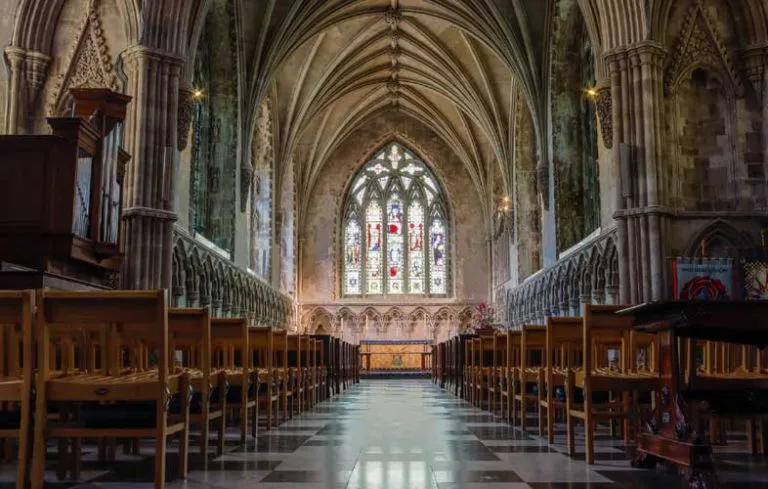
Ever Changing, Ever Growing
Little is known of the early churches built over Alban’s grave. The Shrine of St Alban was the reason for the Abbey’s foundation and the town that grew up around it, and it is said that King Offa of Mercia founded a monastery here in 793.
After the Norman invasion of 1066, William the Conqueror appointed Paul of Caen as the first Norman abbot of St Albans and commissioned a new church. Paul started his great rebuilding of the Abbey with the Tower, which still stands today. This Norman church was built from bricks and tiles saved from the ruins of Roman Verulamium. This ambitious project was completed in 1115, under the rule of Abbot Richard d’Albini.
The only English pope, Adrian IV, was born locally and granted special privileges to the Abbey, enhancing its reputation and power.
In 1213 St Albans Abbey was the meeting place for a group of churchmen and nobles. Their discussions led to Magna Carta which was reluctantly sealed by the king at Runnymede in 1215.
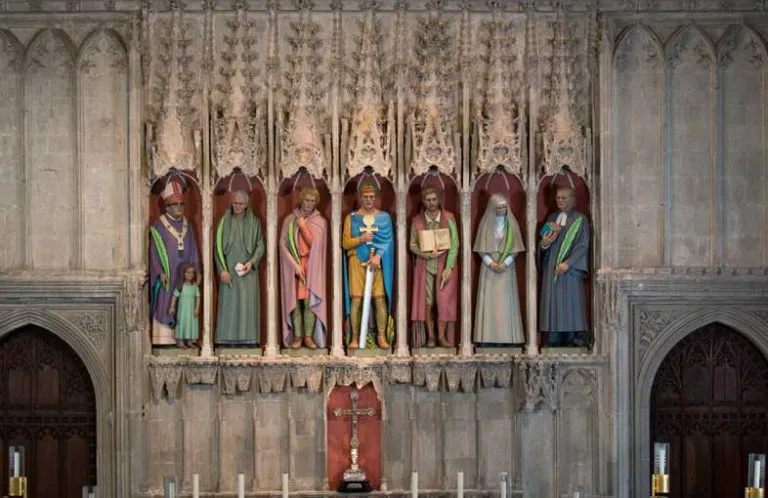
Living and Learning
- The medieval Abbey was famous as a place of learning. The monks who lived here produced high-quality manuscripts in a workshop called the scriptorium. These included bibles and books on science, music and classics.
- St Albans Abbey was closed in December 1539 and most of the buildings were destroyed. The shrines of St Alban and St Amphibalus were demolished and Alban’s relics disappeared.
- In 1553, the people of St Albans bought the church for their own use. However, the upkeep was expensive and by 1832, the Abbey was in a sorry state.
- Wealthy Victorian benefactors paid for the building to be repaired. This included remodelling the West End, removing medieval features and replacing the statues in the High Altar Screen.
- In 1877 what had previously been a local parish church became a cathedral and the seat of the Bishop of St Albans.
- This Cathedral is very much a living Church and continues to grow. Help us keep this amazing story alive.
Organ
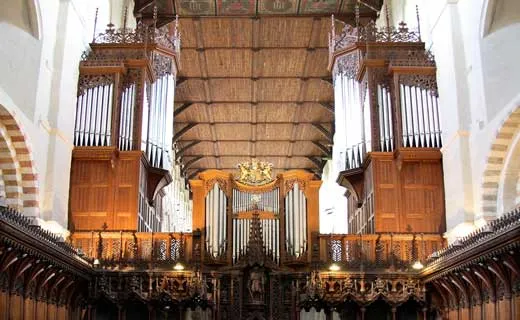
The Cathedral Organ was built in 1962 by Harrison & Harrison of Durham to a design by Peter Hurford (then Master of the Music) and Ralph Downes. It contains over 4,500 pipes, spread across keyboards (manuals) and pedals.
The instrument was revolutionary: it was the first cathedral instrument to be voiced and built on neo-classical lines. It includes certain ranks of pipes – radically re-voiced – from earlier instruments. The logical internal layout and the clarity of speech of the pipes enables a good balance between stops well-suited to solo music, choral accompaniment and congregational singing.
The two facing organ cases were designed by John Oldrid Scott in 1908: the smaller central case dates from 1962. In 2007-9 the organ was comprehensively refurbished by Harrison & Harrison. The organ is the centrepiece of the biennial St Albans International Organ Festival and Competitions, founded by Peter Hurford in 1963. A large number of recordings have been made on the organ.
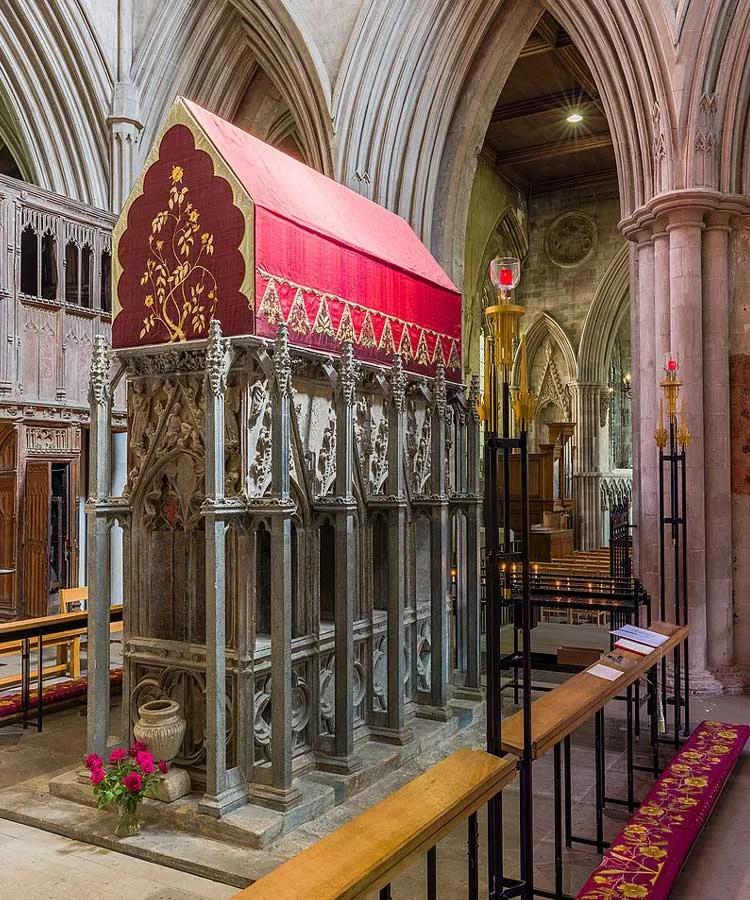
Organists
The master of the music and the assistant master of the music share the responsibility of directing the St Albans Cathedral Choir and the St Albans Cathedral Girls’ Choir respectively. The earliest known name of an organist at St Albans is Adam from the early 13th century. Robert Fayrfax, the prominent English Renaissance composer, is recorded as being organist from 1498 to 1502, and was buried there following his death some 20 years later.
Since 1820 the post of organist and master of the music has been held by a number of well-known musicians, including Peter Hurford, Stephen Darlington and Barry Rose. The current master of the music, since 1998, is Andrew Lucas. The assistant master of music at the cathedral is sometimes also the master of music at St Albans School, for example, Simon Lindley and Andrew Parnell.
Since 1963 the cathedral has been home to the St Albans International Organ Festival, founded by Peter Hurford, and winners of which include Dame Gillian Weir, Thomas Trotter and Naji Hakim.
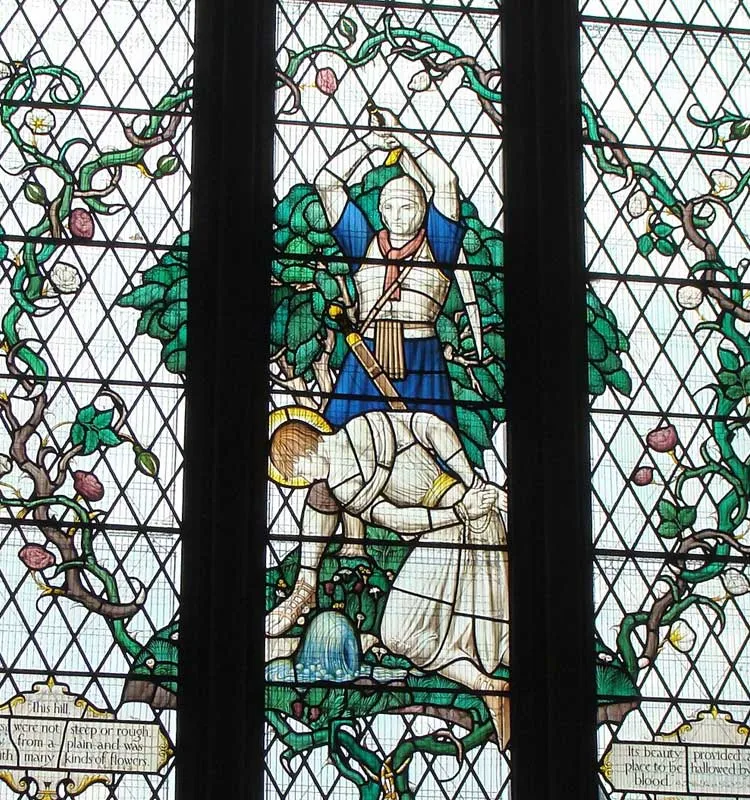
Bells
In total, there are 23 bells housed in the tower. The main ring of 12 bells (with a sharp 2nd) was cast in 2010 by the Whitechapel Bell Foundry. These replaced the previous ring, 8 of which still remain in the tower and are used for the clock chime and carillon; the carillon plays a different tune every day of the week.
In the 17th century the cathedral housed a ring of 5 bells, until they were recast and augmented to 6 in 1699. In 1731 the bells were augmented to a ring of 8 by adding two new bells. Finally, in 2010 the 13 new bells were cast, and were rung for the first time at Easter 2011. The oldest bell in the tower was cast in c.1290 and is still used today as the sanctus bell.
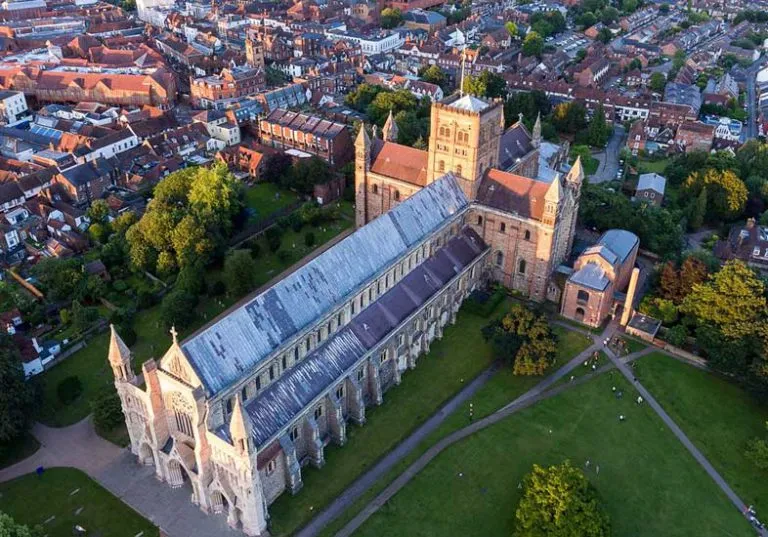
Veneration
Alban is remembered in the Church of England with a Lesser Festival on 22 June and he continues to be venerated in the Anglican, Roman Catholic, and Eastern Orthodox Communions. The Fellowship of Saint Alban and Saint Sergius is also named in part after Alban.
Every year, during the weekend closest to his feast day, St Albans Cathedral hosts the “Alban Pilgrimage”, with huge puppets re-enacting the events of Alban’s martyrdom around the city of St Albans.
Besides his abbey, churches in England dedicated to Saint Alban include the former St Alban, Wood Street in the City of London, St Alban’s Church at Holborn in central London, ones in the London suburbs of Teddington, Croydon, Cheam and Ilford, one in Westcliff-on-Sea in Essex, others in Hull and Withernwick in the East Riding of Yorkshire, one in Swaythling, Southampton, one in Northampton, one in a Norwich suburb, one in Bristol, one in Tattenhall, Cheshire and another in Macclesfield, Cheshire.
There is also St Alban’s, West Leigh near Havant in Hampshire, and the St Alban the Martyr Parish Church of Highgate, Birmingham (including Ark St Alban’s Academy). and St Alban the Martyr Church, Cowley, Oxford. Finally, a church is dedicated to Saint Alban at Earsdon Village, Northumberland, which is the nearest one to Bede’s Holy Island. There is also a St Albans parish and church in Splott, Cardiff.
St Alban is the Patron Saint of the Liberal Catholic Church worldwide.
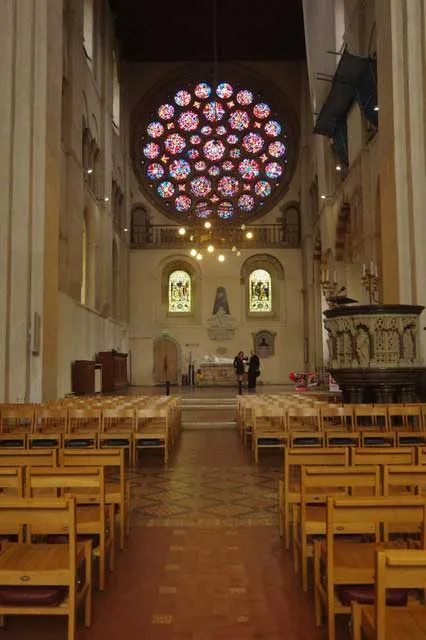
Feast Day – 22nd June
Annual Feast Day of St. Albans Cathedral celebrated on 22nd June.
Mass Time
Weekdays
Saturdays
Church Visiting Time
Contact Info
Sumpter Yard, St Albans,
Hertfordshire, AL1 1BY, England
Phone No.
Tel : +44 1727 890210
Accommodations
How to reach the Cathedral
London Luton Airport is an international airport located in Luton, Bedfordshire, England, situated 28 miles north of Central London is the nearby Airport to the Cathedral.
St Albans Abbey Railway Station in St Albans, Hertfordshire, England is the nearby Train Station to the Cathedral.

